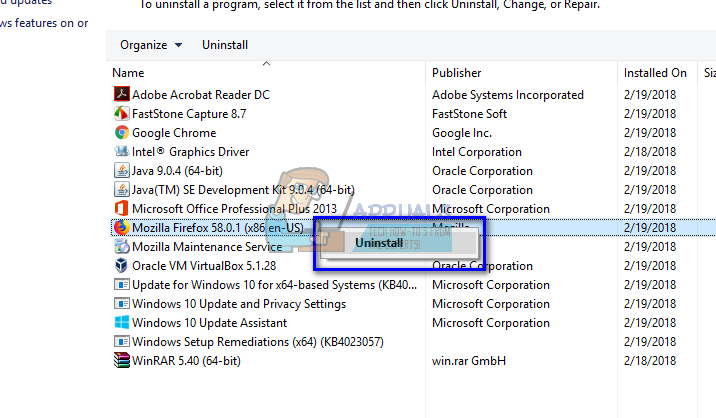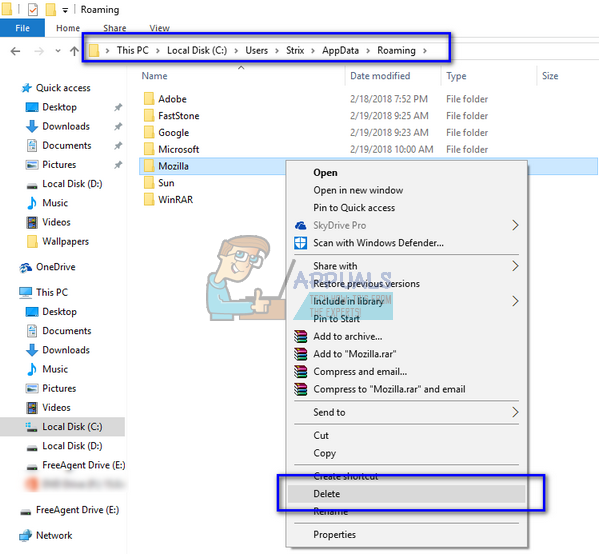Fix: Your Firefox profile cannot be loaded (Updated)
Most modern desktop-oriented Linux distributions have Mozilla Firefox as a default browser, so it can be really frustrating when you get the dreaded “Your Firefox profile cannot be loaded” message. This is frequently caused by the cache in your home directory getting corrupted, so you don’t need to start deleting your stored profile options. There’s a simple way to clear out the cache without losing anything vital.

The .cache/Mozilla directory inside of your home directory holds a bunch of junk files that get created each time you do some browsing and can be safely removed. If you’ve been getting any error when starting Thunderbird that reads something like “Your Thunderbird profile cannot be loaded. It may be missing or inaccessible“, then this will fix that up too.
We will iterate through all the platforms on which this problem is seen. We will start with Linux and work our way to Windows and then MacOS.
For Ubuntu:
Method 1: Delete the Mozilla Cache
- From a terminal window, type the following command:
killall firefox
- This makes sure that there are no running instances of the browser. You can also make sure there are no running instances of Thunderbird with the command killall thunderbird. If you get a message like “firefox: no process found,” then it’s safe to ignore because it just means that there weren’t any instances running. Once you’re done, run the following command from the terminal:
rm -rf .cache/mozilla/*
- Push enter and while you won’t see any output, you can be sure that the files were deleted since you don’t need root access to clean them out. Thunderbird cache files live in this same directory, so this command will clear them out in one fell swoop as well. Any pertinent material that this command clears out will automatically get repopulated as soon as you launch your browser again.

- Running it should take literally a second or two, so once it’s cleared out start the Mozilla Firefox Web browser again. You shouldn’t get any warnings this time because with that cache cleared out the browser should load your profile just fine. While you’ll notice that your history and current logins were reset, this didn’t adjust your browser settings, bookmarks, or saved passwords because they’re kept in a different directory. This way takes care of the problem with a bare minimum of playing around, so you’ll usually want to use it.
Method 2: Delete the Mozilla Cache Graphically
The terminal method is the fastest in most cases, but you can use your graphical file manager too if you’re using any modern Linux implementation. Close the Firefox and Thunderbird apps if they’re running, open the file manager and then hold down Ctrl+H if hidden folders aren’t shown automatically. Double-click on .cache then double-click again on the Mozilla folder.
- Highlight the firefox folder and the Thunderbird one if you have one and were also having problems with that app. Push Shift+Delete and you’ll see a warning message about how this will permanently destroy what’s in there. You can click on the Delete button with confidence because again this will erase your history and saved logins but not important things like bookmarks or passwords.

- Once you’re done, then you can start Firefox up again and you shouldn’t get any warning messages about being unable to load your profile. This essentially performs the same command you did in the terminal above, simply with the graphical file browser so it might be useful if you’re already poking around in your home folder working on fixing something.
In the future, if you end up seeing a “Warning: Unresponsive Script” error repeatedly in Firefox each time you start then you can run this again because it usually corrects that error as well.
For Windows:
Method 1: Creating a new Profile
When you encounter this error in Windows OS, it means that the Firefox profile that the browser is using by default is not accessible. Now the remedy is quite easy; we will create a new profile using a run command and then launch Firefox. After Firefox is launched, we can easily use the backup utility and restore all your previous data saved on your profile. Do note that this method will require the email and password associated with Firefox.
- Press Windows + R, type “firefox.exe -p” and press Enter.
- A new small window will pop up consisting of several options. Click on “Create profile”.

- A new pop up will come forth giving information regarding Firefox profiles. Press Next.

- You will be navigated to another window where you will be asked to input the name of the profile you are making. After inputting a name, press “Finish”.

- Now you will be navigated back to the window where started. Click on “Start Firefox” to launch the browser.
- Once in the browser, click on the menu icon present at the top-right side of the screen and select “Sign in to Sync”.

- Input credentials and you will be back online with all your Firefox profile loaded.
Method 2: Reinstalling Firefox
If the above method doesn’t show any results, we have to reinstall Firefox from scratch after uninstalling it and removing all the local files. This is a known problem with Firefox where some configuration files get corrupt and you are unable to launch the browser properly.
- Press Windows + R, type “appwiz.cpl” in the dialogue box, and press Enter.
- Once in programs and features, navigate through all the list until you file Firefox. Right-click it and select “uninstall”.

- Restart your computer and press Windows + E to launch the file explorer. Now click on “View” and check the option “hidden items”. This is done so we can easily access all the files even if they are hidden from the conventional user.

- Now navigate to the following address:
C:\Users\<UserName>\AppData\Roaming

Here <UserName> is the name of the user of the profile where it is installed (it will be your username of Windows). If you find a Mozilla entry, right-click on it and select “Delete”.
Perform a similar action to the following file path as well:
C:\Users\<UserName>\AppData\Local
- Restart your computer and navigate to Mozilla Firefox official website. Download the latest version and install it. After installing it, try running it again and check if the problem at hand got solved.
For Mac-OS:
Similar to Windows and Ubuntu, this error message also appears in the Mac operating system. The symptoms are the same and so are the remedies. The method to implement those remedies is a little different depending on the operating system to the operating system.
Method 1: Using Profile Manager
We will try either creating a new profile or recover a pre-existing one and see if Firefox launches without any trouble. If it doesn’t launch as expected, we can try uninstalling Firefox, removing all residual files, and reinstalling the browser from the official website.
- Open Safari and navigate to Mozilla Firefox’s official website. Download the latest profile manager tool. Select your operating system and build it when you are prompted.

- If you encounter an error like the one below, it means you have to change preferences for applications to run when downloaded over the internet. Do note that you will require administrator privileges to change the preferences. If the application opens without any problems, skip these steps and jump to creating a new profile.

- Click on the Apple logo present on the top-left side of the screen and select “System Preferences”.

- Once in system preferences, click on the sub-heading “Security and Privacy”.

- Click the lock button present at the near bottom of the screen and enter your credentials to verify. After entering the credentials, the option to allow apps will automatically be changeable. Set it to “Anywhere”. Save changes and exit.
Note: Make sure to disable this setting after you are done with running the profile manager to protect your Mac.

- You can either choose a profile or create a new one. After selecting a profile, click on “Start Firefox”. Hopefully, Firefox will launch without any further problems.

Note: You can also sign-in to Sync in Firefox to restore your previous bookmarks, favorites, etc. You can do it in a similar way we did with Windows OS.
If you are unable to sync to your older profile, you can locate your old Firefox profile if it is still present on your computer and restore it using the profile manager.
- Navigate to the following address:
~Library > Application Support > Firefox

Check if there are any valid Firefox profiles present. If there are, launch the profile manager again, click on New and when the option is given, browse the folder for the pre-existing profile (here navigate to the profile you just discovered earlier). Press OK and your Firefox profile should be recovered.
Note: If this doesn’t work, try deleting the profiles already listed in the profile manager and then creating a new one.
Method 2: Reinstalling Firefox
If the profile manager doesn’t work, we have to resort to reinstalling the application as mentioned before. When you uninstall a software, some of the residual files always get left behind. We have to delete them as well before we can install a fresh copy or the error will repeat itself.
- Click on “Launchpad” and select “AppCleaner”.

- Click on the list icon present at the top-right side of the screen to list all the applications installed on your Mac. Locate Firefox from the list and double-click it to remove. Make sure all the options are checked before clicking the button “Remove”.

- Restart your Mac device. Now navigate to the following file locations:
*~/Library/Application Support/Firefox/ *~/Library/Caches/Firefox/Profiles/
Delete all the files/folder present in the given directories and restart your Mac again.
- Now navigate to the official website of Firefox using Safari, download the latest Firefox client, and install it on your computer accordingly. Hopefully, the problem will be solved.
Note: If you are having trouble uninstalling the application using this program, you can also consider using third-party applications for uninstalling such as Osx uninstaller.